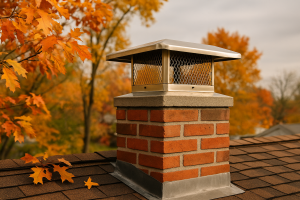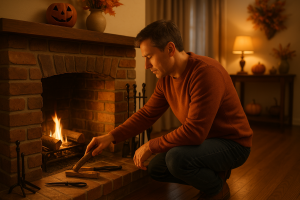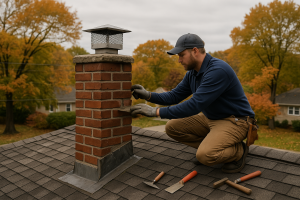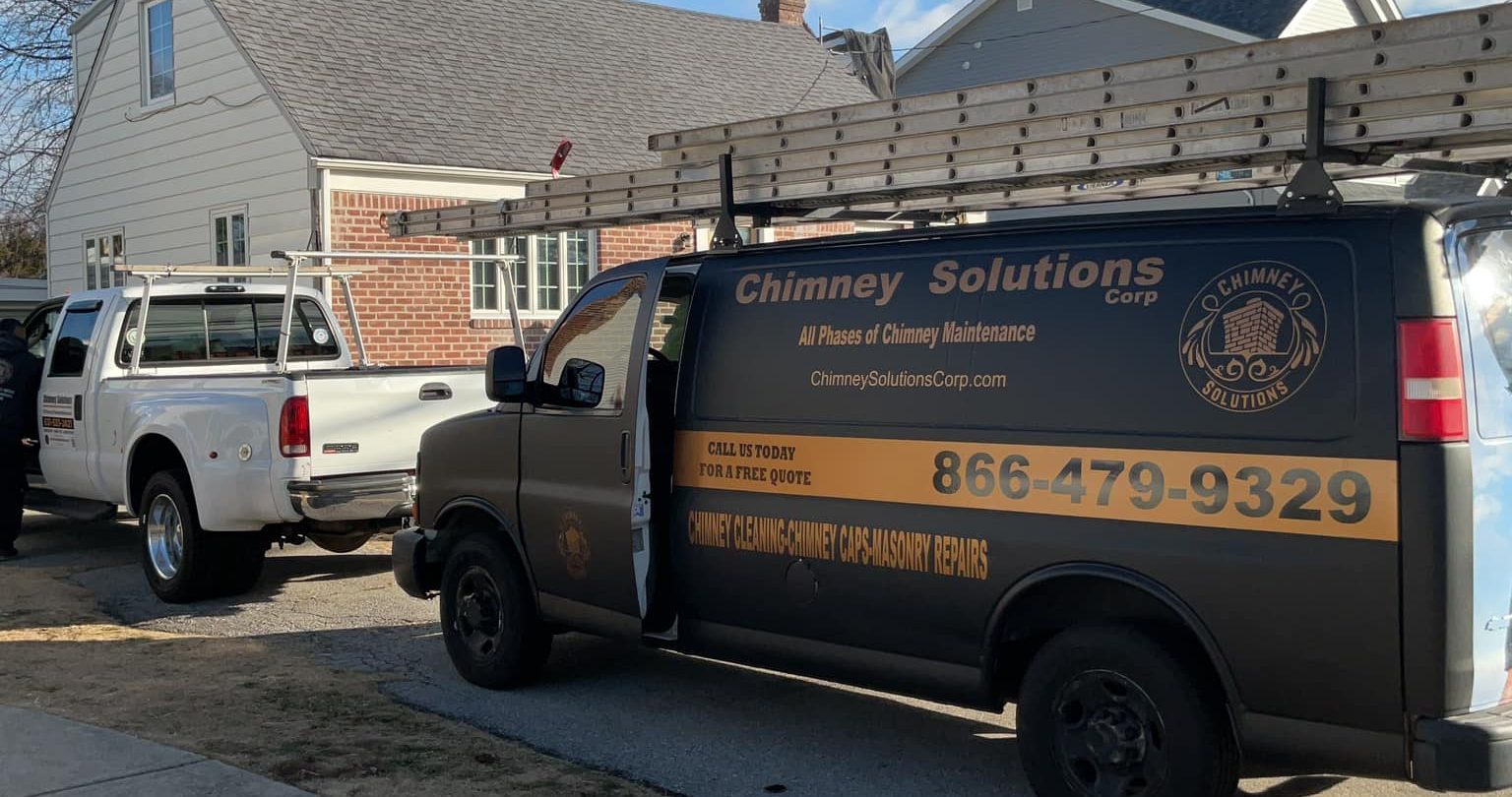Extreme weather is one of the most common causes of chimney damage — especially in regions that experience strong winds, heavy rain, and freeze-thaw cycles. While chimneys are designed to be sturdy, storms can weaken their structural integrity over time, leading to water leaks, brick deterioration, and costly repairs. Understanding the risks associated with high winds and severe weather can help homeowners take preventative steps and maintain a safe, fully-functioning chimney.
The Impact of High Winds on Chimneys
High winds don’t just rattle windows and trees — they can put serious pressure on your chimney. Fierce gusts may loosen mortar joints, dislodge bricks, or tilt your chimney cap out of place. In taller chimney structures, this wind pressure increases the likelihood of misalignment and stress fractures.
When left unaddressed, minor cracks can grow into major structural issues. A tilting or leaning chimney is more than a cosmetic concern — it’s a safety hazard. Winds may also force debris or Animal nests deeper into the chimney flue, contributing to dangerous blockages and poor draft performance.
According to the Chimney Safety Institute of America, regular inspections are essential to ensure that wind-damaged components don’t escalate into chimney fires or collapses.
How Heavy Rain Compromises Chimney Health
Heavy rainfall can have a devastating impact on your chimney over time. Water infiltration is one of the most common types of chimney damage, often entering through cracks in the crown, deteriorated mortar joints, or faulty flashing.
As moisture seeps into the masonry, it weakens the structural bonds of the bricks and promotes freeze-thaw cycles in colder months. This constant expansion and contraction of water leads to efflorescence (white salt stains), brick spalling, and, eventually, chimney collapse if ignored.
Even a small leak may allow rainwater to drip inside your fireplace or living space, damaging walls and ceilings. Excessive rain accumulation can also promote black mold spores, which compromise indoor air quality.
Risks Associated with Faulty Chimney Flashing
Chimney flashing — the sheet metal installed where your chimney meets the roof — is your first line of defense against water penetration. When flashing deteriorates due to age or storm damage, water finds its way into vulnerable points of the roofline and chimney base.
Common flashing issues include rusted metal, lifted edges, or improper installation. Once compromised, flashing can allow moisture to seep into attic spaces, damage insulation, and rot roof framing.
Regular chimney inspections often identify these flashing failures early. Using materials like galvanized metal and ensuring watertight seals at all roof junctions are vital steps in preventing this type of chimney water damage.
The Role of Chimney Caps and Crowns During Storms
Chimney caps and crowns play a crucial role in protecting your chimney during severe weather events. The chimney crown — a concrete or cement layer on top of masonry chimneys — shields against rain and snow. Cracks in the crown can allow water infiltration and cause slow but severe internal damage to the chimney structure.
Meanwhile, a properly fitted chimney cap serves as a barrier against rain, downdrafts, birds, and debris. During strong wind events, poorly installed caps may fly off or warp, exposing the flue to storm elements and increasing the risk of draft issues, blockages, or embers entering the home.
Upgrading to a top-sealing damper or heavy-duty stainless steel cap can provide an added layer of defense, especially for chimneys in storm-prone regions.
Preventive Measures to Minimize Storm Damage
Routine chimney maintenance is the best way to avoid costly repairs caused by storm damage. Certified professionals can identify early warning signs such as loose bricks, deteriorating mortar joints, or signs of water infiltration that may not be visible to the average homeowner.
Preventative steps include:
- Annual chimney inspections by a certified chimney technician
- Waterproofing the chimney with breathable masonry sealants
- Installing or replacing chimney caps and flashing as needed
- Tuckpointing mortar joints showing signs of erosion
These proactive measures protect not only the chimney’s structure but also the home’s interior and the family’s safety.
For more information on weatherproofing and protecting masonry, the National Weather Service offers insight into how heavy storms affect building materials and what to watch out for after major weather events.
When to Call a Professional Chimney Technician
After a strong storm, hurricane, or period of extreme weather conditions, it’s crucial to have your chimney inspected by a certified technician — even if there are no visible signs of damage. Bad weather, including heavy wind, freezing temperatures, and heavy rain impact, can cause hidden vulnerabilities that weaken your chimney’s structural integrity over time. Waiting too long can lead to severe damage, requiring complete chimney replacement rather than simple repairs.
Telltale Signs You Need Immediate Chimney Service
Whether your chimney is made of brick, metal, or a cement chimney crown, look for these common issues after a storm:
- Water stains or discoloration near the fireplace or on nearby walls, which often signal chimney from water leakage or moisture from rain
- A smoking fireplace, poor draft, or the smell of dangerous gases, which could indicate a compromised flue liner or blocked chimney pot
- Cracked, missing, or loose chimney bricks or signs of masonry deterioration from freeze-and-thaw cycles
- Rusted or missing chimney caps or chimney chase covers, which serve as the first defense against moisture intrusion and animal entry
- Musty odors, especially in warmer weather, suggesting mold growth due to trapped moisture inside the masonry walls
Other less obvious signs include masonry cracks, horizontal joint erosion, and roof flashing failure — all of which contribute to potential chimney leaks and dangerous structural issues if left unchecked.
Why You Should Act Quickly After a Storm
If you’ve recently experienced harsh weather conditions, such as a downburst of wind, excessive snow accumulation, or hot summer temperatures, it’s important to recognize that even small damages may evolve into major cracks, chimney deterioration, or unsafe combustion pathways. Chimneys with compromised integrity may allow embers, smoke, or gases to seep back into the living space, putting your family at risk of carbon monoxide poisoning or even a chimney fire.
According to the National Fire Protection Association (NFPA), chimneys should be inspected at least once per year to prevent such hazards and ensure compliance with safety codes.
Trusting Professionals for Thorough Inspections
Partnering with experienced chimney technicians is the safest way to ensure your chimney is fully functional and storm-ready. These experts use specialized tools and cameras to inspect the entire chimney, identify flue through cracks, and assess chimney masonry structure. At Chimney Solutions, our professional chimney services cover everything from chimney waterproofing and masonry repairs to flashing replacement and chimney cover installation — helping to prevent costly repairs down the line.
If you’re unsure whether your chimney sustained storm-related damage, the best course of action is to fill out our [contact form] to schedule an inspection. Taking proactive measures now ensures your home remains safe, your fireplace performs efficiently, and your chimney meets all necessary safety standards.



